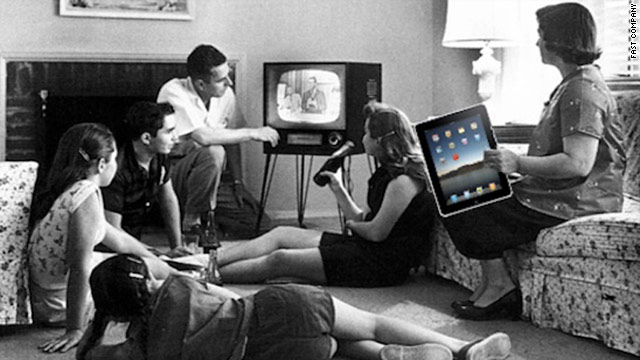Early adopters.
|
My first hint of this was watching my son watch TV. He is arrayed on the couch in a position that might be described as a half-hearted attempt at a headstand. He's watching TV, doing something with his iPad, and texting friends on his phone.
If he had more hands he'd no doubt be working some other device.
This is what the information technology giant Tata Consultancy Services calls "the second screen" -- some other device in use while you're in front of the TV. Increasingly TV producers are trying to take advantage of this.
Tweeting while watching TV began this convergence once companies realized that people continued to use smartphones even while doing other things. This also involved going to other internet channels like YouTube to continue the experience they had on the first screen – the TV.
Networks such as The Discovery Channel are engaging in conversations with viewers and building a growing network of fans. With its vast assortment of networks, including the Animal Channel, the company manages 70 Facebook fan pages with 40-million fans and 20 Twitter accounts with 2.4 million followers.
Wow. I thought they just showed films of cute deer eating leaves. Every now and then when I turn on an NCIS rerun to take my nap I see some sort of invitation inviting me to go online for something or other. Why would I do that?
The apps are out there, of course.
Some of the most popular apps include Miso and GetGlue. These sites provide an app that allows you to select the show of your choice and join the conversation with others in your network even if the show is not being aired currently. Both apps can be linked to your Facebook or Twitter community, allowing you the opportunity to interact with others who share a similar interest.
If I knew how to work my smart phone I might try it. Get this:
ABC was one of the first to try out the Second Screen with this experiment on its property My Generation, in 2010. This iPad app creates a seamless, two-screen, interactive television experience by bridging a cable / satellite connection and an iPad, by measuring analog sound waves using the iPad’s microphone. It looks for certain contours in the audio signal so that it knows when to display a particular poll or other item linking up with a precise moment in the show. This can also trigger ads or links on the Second Screen app, where an ad will be displayed on the primary screen first and then reveal more in depth content through the app.
But will it get up and fetch me some ice cream?



